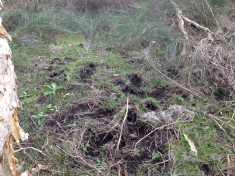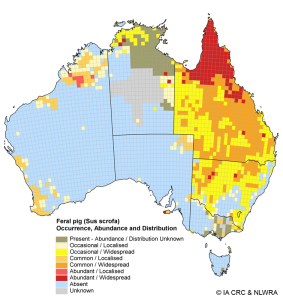by Peter Adams. Feral pigs have a significant impact on Australia’s native resources. This is most obvious in the disturbance they cause by their rooting behaviour. They turn over the soil in search for subterranean food resources such as tubers, roots, rhizomes, fungal fruiting bodies, and invertebrates. Basically, they eat everything they can find. But it is not only plant material. They also eat carrion and live prey, including ground-nesting bird chicks, reptiles, turtle eggs, and even small mammals.
We have been quantifying the damage caused by feral pigs in the northern jarrah forest over the last 10 years. This research indicates that this population of approximately 8,000 feral pigs disturb at least 13 million tonnes of soil every year. This destroys habitat for wildlife, and impacts on water quality in our precious water catchments. It also disrupts seedling recruitment, plant growth, and accelerates erosion.

While signs of their presence are obvious, feral pigs are extremely cryptic, making them a difficult species to study. It is often hard to know where they are, or how many are present. This makes it hard to allocate adequate resources to control their numbers and manage their impacts.
We have been working with community, industry and government partners (Department of Parks and Wildlife, Department of Agriculture and Food WA, and South West Catchments Council) to develop innovative methods to monitor feral pig populations. This team are using thermal sensors mounted in aircraft to detect feral pigs beneath the forest canopy. Due to their large body size and relatively sparse hair covering, feral pigs are typically much hotter than their environment. We can therefore easily differentiate them from other species, such as kangaroos, wallabies, and livestock.

Their current research involves fitting GPS tracking collars to free-ranging feral pigs. Four pigs have been collared to date, with the aim to make this a total of 20 over the next few months. These collars allow the researchers to follow the pig’s movement patterns across the landscape. The collars will also enable us to pinpoint their location when we fly over them with the thermal sensor, and to test the efficacy of the aerial thermal surveillance method.
In the future, it is hoped that this innovative research will provide us with the ability to implement broad scale monitoring of feral pig populations, mapping distribution and density (spatial ‘hot spots’) across the landscape. This work will inform control programs and improve feral pig management throughout Australia.

http://www.feral.org.au/assessing-invasive-animals-in-australia-2008

Hi, I’m working in New Caledonia and we’re a going to do a similar work than yours. We’re a going to put 3 GPS tracking collars on pigs (as a first step, but wish to equip about 20 pigs) and we start thinking about using an aerial thermal sensor to assess population density. Do you have any paper to share about your work, we’ll you be agree to give us some advice?
Best Regards,
Cédric
LikeLike
Hi Cedric, that sounds like a very interesting project. Pigs are certainly not the easiest species to work with. We are still in the early stages of assessing the operational application of aerial thermal sensors to detect feral pigs. At present we don’t have any published data, but I’m certainly happy to provide some advice. I’ll send you an email shortly. Cheers.
LikeLike
Hi Peter, how is your work on aerial thermal sensors going? We are still trying to captur pigs in order to equip them with GPS collar and hope that it will be done in a month or two. Working in a mountain cloud forest is not that easy ! Anyway, just wondering if you’ve got any published paper about feral pig impact that you could share with us? Cheers
LikeLike